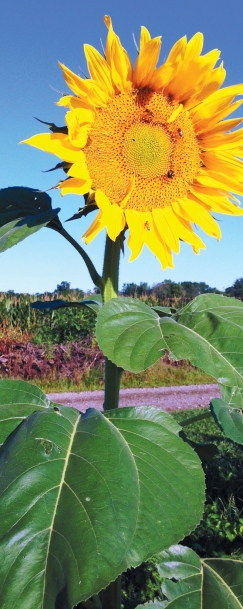Harvesting for Hope
The Ohio State University’s Garden of Hope for cancer survivors
Eat five to seven servings of fruits and vegetables daily, incorporate a colorful variety of produce into your diet, and be consistent. These are three principles that Dr. Steven K. Clinton of the James Cancer Hospital and Dr. Colleen K. Spees of the School of Health and Rehabilitation Sciences have been instilling in the people who visit the JamesCare for Life Garden of Hope, or Survivor’s Garden, since its inception four years ago.
Located in the midst of The Ohio State University’s (OSU) Waterman Farms, the Garden acts as both a service to those who have been touched by cancer, as well as a research project. Studies are designed to promote dietary and lifestyle patterns that can be adopted to diminish the risk of redeveloping cancer and ultimately aide survivors in their quest to acquire a more healthful way of living.
“A plant-based diet with a diverse array of fruits, vegetables, and whole grains over time is how you can reduce your risk of many cancers,” Steven advises. “Next to tobacco, the most important risk factors for cancer are food, nutrition, and lifestyle.”
The Garden of Hope enables those who have been afflicted by cancer to harvest fresh, phytochemical-packed produce such as beets, berries, eggplant, and sweet potatoes several times a week. Coined as an “urban oasis,” this bountiful garden not only provides current and past patients with a plethora of cancer-fighting crops and herbs, but it also serves as a place of solace and support.
“Survivors feel like it’s their own,” Colleen explains. “In their world of cancer chaos, it’s the one place they can come to feel a sense of peace and tranquility. They can say, ‘This is my space and these people understand my journey, they know where I am at right now.’” Steven describes the time surrounding cancer diagnosis as a vulnerable state for those affected, one where self-control and independence are sacrificed for succumbing to rigors of tightly scheduled medications, surgery, and radiation.
“You want to do things to help yourself, but yet so much is being done to you,” says Steven. When rigorous cancer treatments end, one adapts to an entirely new mindset—how can I live a better life for the years I have remaining? The JamesCare for Life program, a sponsor of the Garden of Hope, facilitates this process through educational opportunities both in the classroom and out in the Garden.
Anna Deri, a 65-year-old survivor of breast cancer, learned a wealth of information at the biweekly lectures when she was a participant in Colleen’s Healthy Harvest Study this past season. Expert food educators voluntarily came in to talk about the nutritional benefits of the produce offered in the Garden, provided cooking demonstrations and taught food safety practices and preserving methods like canning and freezing.
At the completion of the study, Anna saw positive changes across the board. Most notably, she dropped nearly 13 pounds and improved in several biochemical measures of nutritional status.
“I walked away with everything,” Anna says. “I was really hung up on organic,” but she learned that the locality aspect of food is of greater importance than if it is organic. “The Garden enables survivors to come in touch with where their food comes from,” says Steven.
At the present time, the research team has not chosen to certify the area as “organic” for many reasons. According to Farm Manager Glenn Mills, “the organic fertilizers use composted animal manure for their nutrient source, which could lead to E. coli or Salmonella exposure,” especially because so many of the survivors are immunocompromised post treatment. In addition, no pesticides are used in the Garden.
When asked how the Garden was established, Steven proudly says, “This originates with Abraham Lincoln.” He expands on this thought by explaining how Lincoln signed the Land-Grant College Act of 1862, which proclaimed that new states west of the East Coast needed to have universities that serve the people of the state. OSU is a land-grant university that was supported by that initial vision. So with the collaboration of cancer researchers and other faculty at OSU, the Garden of Hope was born to help fulfill this desire to grow food products with a high concentration of phytochemicals to help fend off the reoccurrence of cancer.
As for future plans, both Steven and Colleen would like to expand the program, recruit more volunteers, and continue to seek grants and funds that will enable the Garden to thrive. “There is a cycle of life you can witness over a season. There is renewal and comfort that comes from seeing yourself as part of that process,” says Steven.
The Garden of Hope indeed restores a sense of self-sufficiency and hope.
If you want to get involved by volunteering in the Garden of Hope call 614-293-6428, or visit cancer.osu.edu/giving-back/volunteering/jamescare-for-life for more information.






